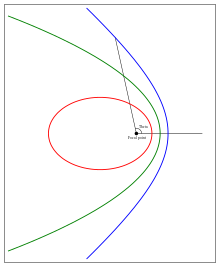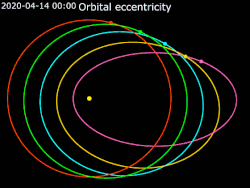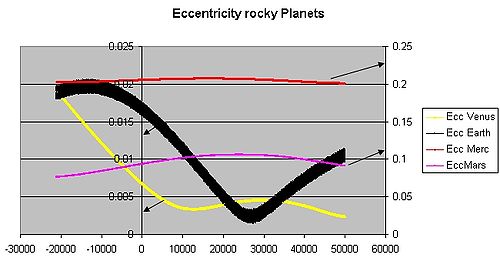Orbital eccentricity
It is normally used for the isolated two-body problem, but extensions exist for objects following a rosette orbit through the Galaxy.The eccentricity of this Kepler orbit is a non-negative number that defines its shape.where E is the total orbital energy, L is the angular momentum, mrdc is the reduced mass, andthe coefficient of the inverse-square law central force such as in the theory of gravity or electrostatics in classical physics:[2]: 12–17 For values of e from 0 to just under 1 the orbit's shape is an increasingly elongated (or flatter) ellipse; for values of e just over 1 to infinity the orbit is a hyperbola branch making a total turn of 2 arccsc(e) , decreasing from 180 to 0 degrees.Radial trajectories are classified as elliptic, parabolic, or hyperbolic based on the energy of the orbit, not the eccentricity.Keeping the energy constant and reducing the angular momentum, elliptic, parabolic, and hyperbolic orbits each tend to the corresponding type of radial trajectory while e tends to 1 (or in the parabolic case, remains 1).For a repulsive force only the hyperbolic trajectory, including the radial version, is applicable.gives the projection angle of a perfect circle to an ellipse of eccentricity e. For example, to view the eccentricity of the planet Mercury (e = 0.2056), one must simply calculate the inverse sine to find the projection angle of 11.86 degrees.For Earth, orbital eccentricity e ≈ 0.01671, apoapsis is aphelion and periapsis is perihelion, relative to the Sun.Mercury has the greatest orbital eccentricity of any planet in the Solar System (e = 0.2056), followed by Mars of 0.0934.Such eccentricity is sufficient for Mercury to receive twice as much solar irradiation at perihelion compared to aphelion.Other Trans-Neptunian objects have significant eccentricity, notably the dwarf planet Eris (0.44).Over hundreds of thousands of years, the eccentricity of the Earth's orbit varies from nearly 0.0034 to almost 0.058 as a result of gravitational attractions among the planets.Neptune's largest moon Triton has an eccentricity of 1.6×10−5 (0.000016),[5] the smallest eccentricity of any known moon in the Solar System;[citation needed] its orbit is as close to a perfect circle as can be currently[when?][6] Their comparatively high eccentricities are probably due to under influence of Jupiter and to past collisions.Non-periodic comets follow near-parabolic orbits and thus have eccentricities even closer to 1.It was discovered 0.2 AU (30000000 km; 19000000 mi) from Earth and is roughly 200 meters in diameter.As a result, in the northern hemisphere, autumn and winter are slightly shorter than spring and summer—but in global terms this is balanced with them being longer below the equator.[15][16] Apsidal precession also slowly changes the place in Earth's orbit where the solstices and equinoxes occur.This is a slow change in the orbit of Earth, not the axis of rotation, which is referred to as axial precession.Over the next 10000 years, the northern hemisphere winters will become gradually longer and summers will become shorter.Any cooling effect in one hemisphere is balanced by warming in the other, and any overall change will be counteracted by the fact that the eccentricity of Earth's orbit will be almost halved.[17] This will reduce the mean orbital radius and raise temperatures in both hemispheres closer to the mid-interglacial peak.Of the many exoplanets discovered, most have a higher orbital eccentricity than planets in the Solar System.The exoplanets discovered show that the Solar System, with its unusually-low eccentricity, is rare and unique.[18] One theory attributes this low eccentricity to the high number of planets in the Solar System; another suggests it arose because of its unique asteroid belts.[20][21] The grand tack hypothesis of the Solar System also helps understand its near-circular orbits and other unique features.
Elliptic (eccentricity = 0.7)
Parabolic (eccentricity = 1)
Hyperbolic orbit (eccentricity = 1.3)

0 · 0.2 · 0.4 · 0.6 · 0.8
Eccentricity (disambiguation)Kepler orbitOrbital mechanicsOrbital elementsArgument of periapsisInclinationMean anomalyOrbital nodesSemi-major axisTrue anomalytwo-body orbitsCircular orbitElliptic orbitTransfer orbitHohmann transfer orbitBi-elliptic transfer orbitParabolic orbitHyperbolic orbitRadial orbitDecaying orbitDynamical frictionEscape velocityKepler's equationKepler's laws of planetary motionOrbital periodOrbital velocitySurface gravitySpecific orbital energyVis-viva equationCelestial mechanicsBarycenterHill spherePerturbationsSphere of influenceN-body orbitsLagrangian pointsHalo orbitsLissajous orbitsLyapunov orbitsEngineering and efficiencyMass ratioPayload fractionPropellant mass fractionTsiolkovsky rocket equationGravity assistOberth effectOrbital maneuverOrbit insertionastrodynamicsastronomical objectdimensionless parametercircleparabolicescape orbithyperbolaconic sectionstwo-body problemrosetteeccentricitynon-negative numberParabolic trajectoryHyperbolic trajectoryorbital energyangular momentumreduced masscentral forcegravityelectrostaticsclassical physicsKepler problemstandard gravitational parameterspecific relative angular momentumarccscellipseinverse sineMedieval Latinorbital state vectorseccentricity vectorelliptical orbitsperiapsisapoapsiscenter of massMercuryTritonNeptuneUranusJupiterSaturnLuna (Moon)10 HygieaQuaoarMakemakeHaumea2 Pallas3 Juno324 BambergaGonggong8405 Asbolus5145 Pholus944 HidalgoNereid2001 XA2555335 DamoclesHalley's CometComet Hale-BoppComet Ikeya-SekiComet McNaughtC/1980 E1ʻOumuamua2I/BorisovSolar Systemsolar irradiationplanet statusTrans-Neptunian objectsunknown object(s)Earth's orbitVenus'sGalilean moonsEuropaGanymedeCallistoirregular moonsasteroidsCometsPeriodic cometsparabolic orbits
